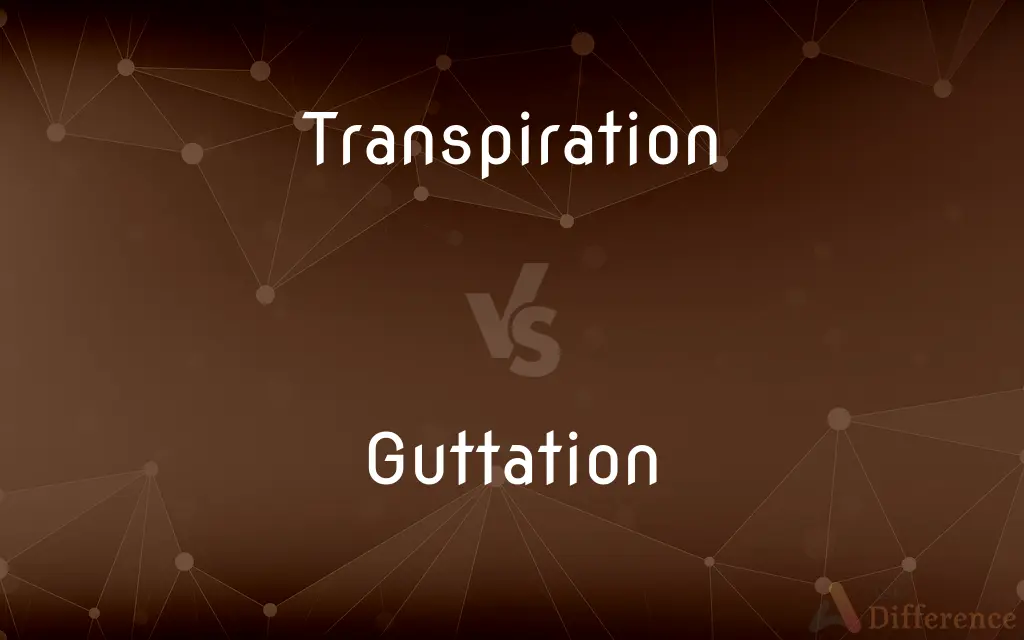Transpiration vs. Guttation — What's the Difference?
By Tayyaba Rehman — Updated on October 27, 2023
Transpiration is the process by which plants release water vapor from their leaves into the atmosphere. Guttation is the exudation of droplets of water from the tips or edges of leaves of certain plants.

Difference Between Transpiration and Guttation
Table of Contents
ADVERTISEMENT
Key Differences
Transpiration is a critical aspect of the plant's water cycle, where water vapor escapes from the plant's surface, primarily from the stomata of leaves. This evaporation helps drive the absorption of water at the plant's roots from the soil. Guttation, conversely, is a process where water is pushed out directly as liquid, typically at the leaf tips or edges, due to root pressure.
Both Transpiration and Guttation are mechanisms that plants use to manage water, but they operate under different circumstances and for different reasons. While Transpiration plays a role in nutrient transport and temperature regulation, Guttation happens mainly when soil moisture levels are high, and plants can't transpire quickly enough.
Transpiration is a continuous process and primarily occurs during the daytime when the stomata are open, and the atmosphere is warmer. Guttation usually happens during the night or early morning when atmospheric humidity is high, and transpiration rates are low.
Another point of differentiation between Transpiration and Guttation is in what is being released. Transpiration involves pure water vapor, while Guttation droplets can contain dissolved nutrients and minerals. This means that over time, white crusty residues can be seen on the leaf surfaces where Guttation has occurred, which is not the case with Transpiration.
Comparison Chart
Nature
Release of water vapor.
Exudation of liquid water droplets.
ADVERTISEMENT
Time of Occurrence
Primarily during the day.
Night or early morning.
Caused by
Evaporation through stomata.
Root pressure when soil moisture is high.
Composition
Pure water vapor.
Contains dissolved nutrients and minerals.
Role
Nutrient transport, cooling, and water regulation.
Release of excess water when transpiration is slow.
Compare with Definitions
Transpiration
Evaporation of water from plant surfaces, mainly leaves.
The rapid Transpiration in cacti helps them survive in hot climates.
Guttation
The release of liquid water droplets from plants, typically from leaf tips.
Morning walkers often notice Guttation on grass blades.
Transpiration
A mechanism that aids in nutrient transport within plants.
Transpiration drives the movement of minerals from the roots to the leaves.
Guttation
Not to be confused with dew, it's a plant's direct water exudation.
Dew forms from atmospheric moisture, whereas Guttation is from the plant itself.
Transpiration
The process by which water vapor is released by plants into the atmosphere.
Plants contribute to the humidity of rainforests through Transpiration.
Guttation
Can lead to the formation of white residues on leaves.
The minerals left behind after Guttation can be seen as white spots.
Transpiration
Transpiration is the process of water movement through a plant and its evaporation from aerial parts, such as leaves, stems and flowers. Water is necessary for plants but only a small amount of water taken up by the roots is used for growth and metabolism.
Guttation
A result of root pressure in certain plants.
When soil moisture is abundant, Guttation is more likely to occur.
Transpiration
The act or process of transpiring, especially through the stomata of plant tissue or the pores of the skin.
Guttation
Occurs when transpiration is slow, and soil moisture is high.
After watering the plant, Guttation might be observed the next morning.
Transpiration
(botany) The loss of water by evaporation in terrestrial plants, especially through the stomata; accompanied by a corresponding uptake from the roots.
Guttation
Guttation is the exudation of drops of xylem sap on the tips or edges of leaves of some vascular plants, such as grasses, and a number of fungi. Guttation is not to be confused with dew, which condenses from the atmosphere onto the plant surface.
Transpiration
(physiology) The process of giving off water vapour through the skin or mucous membranes.
Guttation
The exudation of water from leaves as a result of root pressure.
Transpiration
The passage of gases through fine tubes.
Guttation
(botany) The exudation of drops of water from the leaves of some vascular plants as a result of root pressure.
Transpiration
The act or process of transpiring or excreting in the form of vapor; exhalation, as through the skin or other membranes of the body; as, pulmonary transpiration, or the excretion of aqueous vapor from the lungs. Perspiration is a form of transpiration.
Transpiration
The evaporation of water, or exhalation of aqueous vapor, from cells and masses of tissue.
Transpiration
The passing of gases through fine tubes, porous substances, or the like; as, transpiration through membranes.
Transpiration
The passage of gases through fine tubes because of differences in pressure or temperature
Transpiration
The process of givng off or exhaling water vapor through the skin or mucous membranes
Transpiration
The emission of water vapor from the leaves of plants
Transpiration
A cooling mechanism for plants.
On hot days, Transpiration keeps plants from overheating.
Transpiration
A part of the plant's water regulation system.
Transpiration rates vary depending on environmental conditions.
Common Curiosities
Is Transpiration the same as Guttation?
No, Transpiration releases water vapor, while Guttation exudes liquid water droplets.
Is the water released by Guttation pure?
No, it often contains dissolved nutrients and minerals.
Can we see Transpiration happening?
Not directly, but you can observe its effects, like leaf cooling.
Why might Guttation be mistaken for dew?
Both appear as water droplets on plants, but their origins are different.
What causes Guttation in plants?
Root pressure, especially when soil moisture is high and Transpiration is slow.
Are all plants capable of Guttation?
No, Guttation is observed in specific plants under certain conditions.
When does Guttation typically occur?
Guttation usually happens at night or early morning.
What are the stomata's role in Transpiration?
Stomata, tiny pores on leaves, allow water vapor to escape during Transpiration.
In which climates might Guttation be more observed?
In humid climates or conditions with consistent soil moisture, Guttation is more common.
Can Transpiration cool down plants?
Yes, Transpiration helps in cooling plants, similar to how sweating cools humans.
Which process contributes more to atmospheric humidity: Transpiration or Guttation?
Transpiration, due to its larger scale and continuous nature.
Is there a relationship between Transpiration and photosynthesis?
Yes, Transpiration aids photosynthesis by maintaining water and nutrient flow in plants.
What regulates Transpiration in plants?
Factors like light, temperature, humidity, and wind influence Transpiration rates.
Can Guttation droplets harm plants?
Not usually, but over time, mineral residues from Guttation can accumulate on leaves.
How is Transpiration essential for nutrient transport?
It creates a suction that pulls water and nutrients from the roots to other parts of the plant.
Share Your Discovery

Previous Comparison
Jaguar vs. Panther
Next Comparison
Unbeknownst vs. UnbeknownAuthor Spotlight
Written by
Tayyaba RehmanTayyaba Rehman is a distinguished writer, currently serving as a primary contributor to askdifference.com. As a researcher in semantics and etymology, Tayyaba's passion for the complexity of languages and their distinctions has found a perfect home on the platform. Tayyaba delves into the intricacies of language, distinguishing between commonly confused words and phrases, thereby providing clarity for readers worldwide.












































